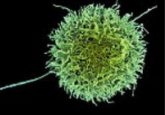How does the body respond to parasitic infections?

CD22 helps regulate the immune response to parasitic infections in mice.
An international collaboration of researchers led by the University of Liège (Belgium) has found an unknown and unexpected mechanism that regulates the immune response against helminth infections. The finding could help develop more effective interventions for parasitic infections.
Almost a quarter of the global population is infected by helminths, worm-like parasites that can reside in the intestine for long periods, often without symptoms. Helminth infection triggers several immune responses, including the production of interleukin-4 (IL-4). Helminth-induced IL-4 production causes the expansion of virtual memory CD8+ T cells (TVM cells), which the researchers previously found enhances viral infection control during co-infections with helminths and viruses. However, the mechanisms regulating IL-4-dependent TVM cell activation and expansion are unclear.
To investigate this, the researchers performed single-cell RNA sequencing of TVM cells from mice infected with Heligmosomoides polygyrus, an intestinal roundworm found in rodents. They found that CD22 – a surface protein that is usually found on B cells and prevents excessive immune reaction – was upregulated.
 Harnessing an extremophile’s bioactive compound for industrial applications
Harnessing an extremophile’s bioactive compound for industrial applications
A bioactive compound produced by an extremophilic bacterium has potential industrial applications.
Further experiments showed that CD22 expression was required to limit IL-4-driven TVM cell expansion and to regulate their activation during helminth infection. Therefore, the researchers concluded that helminth infection induces IL-4, which drives the expansion and activation of TVM cells, and this process is counter-inhibited by CD22.
Discussing CD22, senior author Benjamin Dewals explained: “This receptor plays a crucial role in regulating immune responses. Its presence on TVM cells acts as a brake, limiting their excessive activation and thereby preventing excessive inflammation.”
Understanding this mechanism and the balance between responding to infection and preventing an overreaction of the immune system could help pave the way for new strategies to enhance defenses against infections and mitigate excessive inflammatory reactions. “Further research is needed to determine whether a similar phenomenon exists in humans and how this discovery could be applied in medicine,” concluded Dewals.





